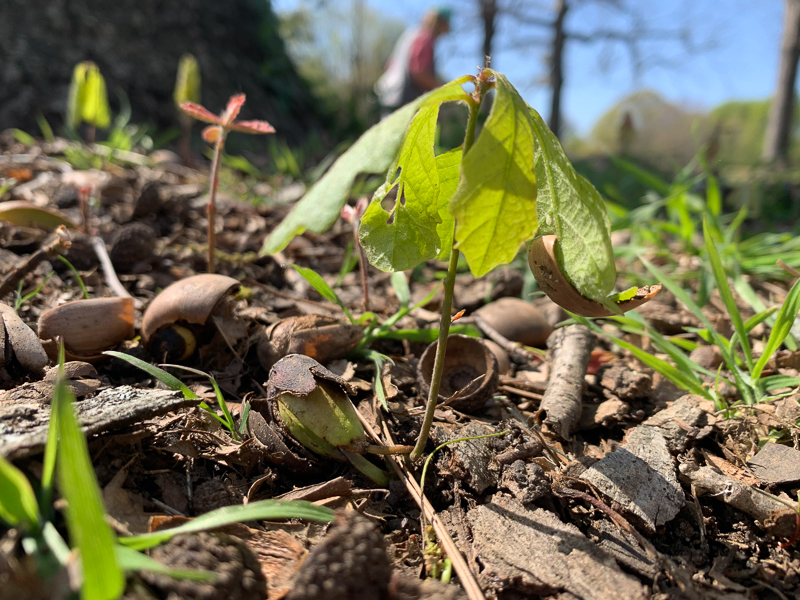Nature Now! Acorns: This is just nutty
For immediate release ‐ April 20, 2021
Nature Now
Contact: Jessica Wackes, 919.707.9850. Images available upon request
 A White Oak sapling and sprouting acorn. Photo: Dr. Bronwyn Williams.
A White Oak sapling and sprouting acorn. Photo: Dr. Bronwyn Williams.
Contributed by Naturalist Center intern Sam Coley
Imagine you’re an acorn that just dropped from the branch of a huge White Oak tree (Quercus alba). Your first question might be, “What am I? What even is an acorn?” If you’re having an existential crisis about being an acorn, don’t worry! An acorn is simply the fruit or nut of an oak tree; each acorn contains a single seed encased in a tough outer shell. The genus Quercus is divided into two groups: the white oaks and the red oaks. Oak species from both groups are found throughout North Carolina.
If you have pollen allergies, you are familiar with the first step of creating an acorn. Oak trees have separate male and female flowers. Pollen from a male flower (the pollen-producing or male parts are called catkins) is transferred via wind to a female flower. If pollination and fertilization occur, a baby acorn is created. After about five months for white oak trees and six to seven for red oaks, the mature acorns are ready to fall. If you remember, I said you’re a White Oak acorn so that means you dropped off the tree in the last few days of August or in September. Once on the ground, acorns lie dormant until the following spring.
Acorns face many challenges once they’ve dropped and most do not go on to produce huge oak trees. When an oak tree drops its acorns, they usually don’t travel very far. Even small acorns are heavy and normally end up lying in piles around the base of the oak tree. This is a problem for acorns for a couple of reasons. First, acorns need sunshine to start growing and they can’t get much under the shady canopy of a large oak. Second, there may be a high concentration of acorns in a small area. These acorns need more space to start growing first into seedlings, and if lucky, into a large tree. So, who comes to the rescue? Squirrels!
 Eastern gray squirrel burying an acorn in fall.
Eastern gray squirrel burying an acorn in fall.
These little rodents allow for the easy transport of acorns throughout an ecosystem. They can even help new oak trees spread uphill. Why would a squirrel want to help move acorns around in the fall? Well, their reasons are purely selfish; the squirrels are hiding all those acorns from other animals so they can store and consume them later. Acorns are packed with nutrients and, in addition to squirrels, animals such birds, raccoons, opossums, bears and white-tailed deer love to eat them. Over the course of the winter months, squirrels will go back to these hidden caches to snack on all those delicious acorns. But squirrels are forgetful and may lose over 70% of the acorns they hide.

A mature White Oak tree. Photo: Sam Coley.
Oak trees can help keep squirrels in line by controlling the number of acorns they produce each year; this phenomenon is referred to as masting. Masting is a cyclical pattern of seed production where every 2 to 5 years, trees over a large area synchronize an overproduction of nuts, fruits or berries. Scientists still aren’t sure why oaks vary their acorn production every few years. One theory suggests that oaks occasionally produce a large crop to ensure that some of the acorns can survive predators, essentially producing too many acorns for all the squirrels to eat. Producing that many acorns forces the trees to cut back or stop acorn production completely the following years while they build up resources for another mast year. During low or zero acorn production years, squirrel (and other rodent) populations may noticeably decline because squirrels live almost exclusively on acorns in the winter and early spring. However, squirrels can resort to other food sources like other types of nuts, insects or plant material.
Now it’s springtime and, because you are a White Oak acorn, you will start germinating or growing immediately. Red oak acorns, on the other hand, must wait a whole extra year before they germinate and start to grow! Red and white oak acorns first extend a long taproot down into the soil before the shoot starts growing upwards, so saplings can be difficult to transplant. It will be a very long time before you are an old enough White Oak tree to produce your own acorns—maybe up to 20 years! Mature oak trees are not only beautiful but play an essential role in the health of our environment. Please let a few of those forgotten buried acorns become future oak trees!
For more information about our upcoming activities, conservation news and ground-breaking research, follow @NaturalSciences on Instagram, Twitter and Facebook. Join the conversation with #visitNCMNS.

